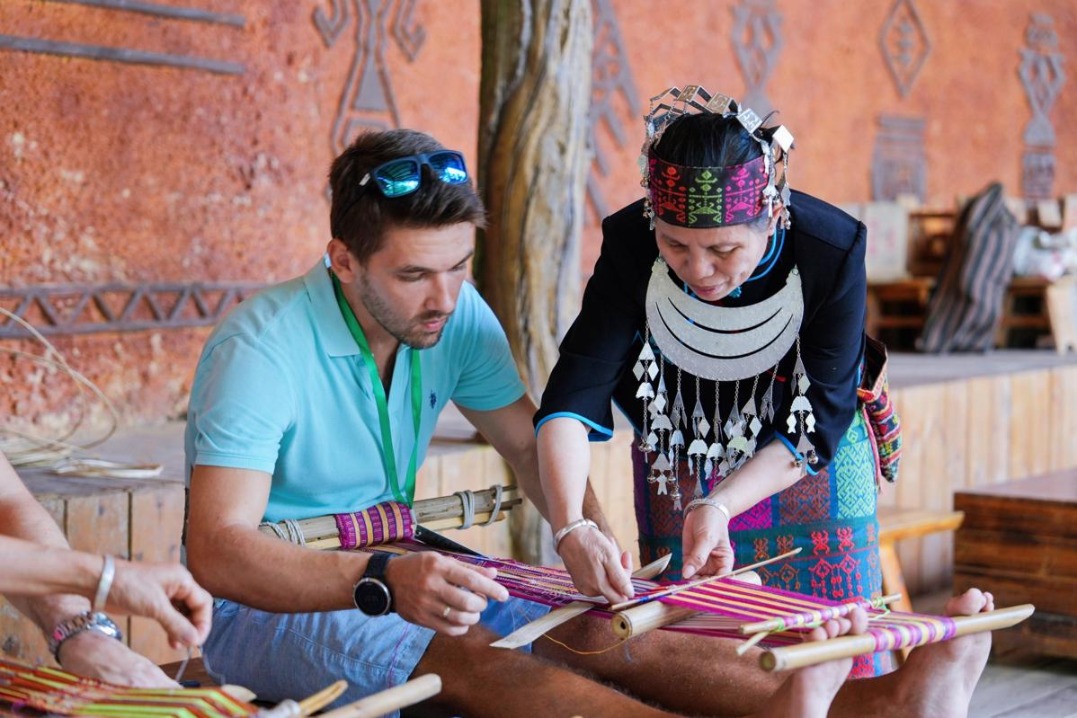Cities get new lease on life
Moves come as status of urban renewal is elevated to systematic growth pillar

As China's decade-long property market boom cools, policymakers are steering the world's second-largest economy toward a more sustainable alternative — revitalizing aging cities.
By positioning urban renewal as a key strategy to stimulate domestic demand, Beijing is calibrating growth drivers while addressing deep-seated social needs, experts and executives said.
Investment aimed at breathing new life into dilapidated residential areas, obsolete industrial sites, and underutilized public spaces will translate into substantial demand for various industries, increased values for existing assets and a notable upgrade for the urban environment, they added.
Their comments came after the country's top leadership has elevated urban renewal to a systematic growth pillar during high-level tone-setting meetings, prioritizing maximizing the use of existing facilities over large-scale expansion.
President Xi Jinping highlighted that China's urbanization is evolving from rapid growth to stable development, and urban development is shifting from a stage of large-scale expansion to one focused on improving the quality and efficiency of existing urban areas, during the Central Urban Work Conference in mid-July.
Over the past few decades, China has experienced the largest and fastest urbanization process in human history. According to the National Bureau of Statistics, its urbanization rate, which measures the ratio of permanent urban residents relative to the total population, reached 67 percent last year.
Two weeks later, Xi, who is also general secretary of the Communist Party of China Central Committee, reiterated the need to promote urban renewal in a high-quality manner at a meeting held by the Political Bureau of the CPC Central Committee when mapping out priorities for economic work in the second half of the year.
The Ministry of Housing and Urban-Rural Development pledged in December to try to complete the renovation of aging urban residential communities built before the end of 2000 by the year 2025.
"By 2030, over 10 billion square meters of residential buildings will be more than 30 years old, and even if we only renovate 10 percent of that each year, that's still 1 billion square meters," said Zhao Yanjing, a professor specialized in urban economics at Xiamen University.
To put this into perspective, the total new construction area nationwide last year, according to data from the National Bureau of Statistics, was less than 740 million square meters, and even at the peak in 2019, it stood at some 1.67 billion square meters.
Even at such a pace, the aging residential buildings would require at least a decade to address, by which time even more properties will come to the stage where reconditioning work is needed, Zhao said.
"This means that as the real estate market shifts from a focus on constructing new houses to enhancing existing ones, the overall market size will likely be fairly large," Zhao said. "These renewal projects will generate substantial economic activity, helping to offset the slowdown in the real estate market, while also improving the living conditions of our citizens."
From 2019 to 2024, China renovated 280,000 aging residential communities, benefiting more than 120 million people, data from the ministry showed.
China's urban renewal initiatives have moved beyond the mere renovation of old residential communities. Abandoned factories become innovation hubs; dormant warehouses are transformed into cultural venues; and urban villages are retrofitted into affordable housing zones.
"As the country moves away from a growth model centered on new construction, the ability to extract value from our existing facilities will become increasingly important," said Yang Baojun, president of the Urban Planning Society of China and former chief economist of the Ministry of Housing and Urban-Rural Development.
In Wuxi, Jiangsu province, an urban renewal initiative, which began in 2019, has transformed a patchwork of industrial remnants, including a textile factory and an ironworks, into a multifunctional hub blending tech industry, digital culture and community spaces.
The industrial park has so far attracted over 100 enterprises, generating annual tax contributions exceeding 15 million yuan ($2.1 million), according to local authorities.
"Urban renewal is no longer about demolition," Yang said. It's about reprogramming urban DNA economically, socially and functionally."
Chinese cities are sitting on a gold mine of undervalued assets. The key is to find innovative ways to activate and repurpose these existing resources, rather than constantly pursue new development, Yang added.
In April, the Ministry of Finance pledged fiscal support for urban renewal projects in up to 20 cities this year, prioritizing megacities, superlarge cities and key urban centers along the Yellow and Pearl rivers.
Centrally administered municipalities and cities in the country's western regions qualify for subsidies of up to 1.2 billion yuan each. Cities in central regions may receive up to 1 billion yuan, while those in eastern regions are eligible for up to 800 million yuan.
However, experts cautioned that the scale and complexity of these urban renewal projects are such that government funding alone is simply not enough. Attracting private investment will be crucial to the long-term sustainability of such initiatives.
Dong Yu, executive vice-president of Tsinghua University's China Institute for Development Planning, said: "These projects require substantial up-front investments and can take years to complete. For private enterprises to get involved, there needs to be a viable business model offering reasonable and stable returns."
China issued a guideline in mid-May to increase policy and financial support for urban renewal projects, vowing to establish a sustainable urban renewal model that is government-led, market-driven and publicly engaged.
Localities can explore the "public-private partnership plus concession" approach, in which the government grants private enterprises long-term operating rights over ancillary facilities, such as parking lots and charging stations, in the vicinity of the urban renewal sites, Dong said.
In the Fuli residential community in Pingxiang, Jiangxi province, property management fees and parking fees now serve as a reliable source of income for renewal project developers.
The project has focused on core infrastructure upgrades, such as road paving and utility network renovations, as well as the expansion and enhancement of parking facilities, said Yang Qian, general manager of Boyue Construction and Development Co.
The Jiangxi provincial branch of China Development Bank has been involved from the beginning, providing 10 million yuan in long-term loans to support the project. More importantly, its financing model incorporates user fees as potential revenue sources, Yang said.
Today's Top News
- A life dedicated to science and devotion to motherland
- Party plenum to shape next five-year plan
- Afghanistan, Pakistan agree to ceasefire
- Xi congratulates new chairperson of Kuomintang
- Constructive Sino-US talks encouraged
- Ball in US court to prove it is not just talking for the sake of talk






























